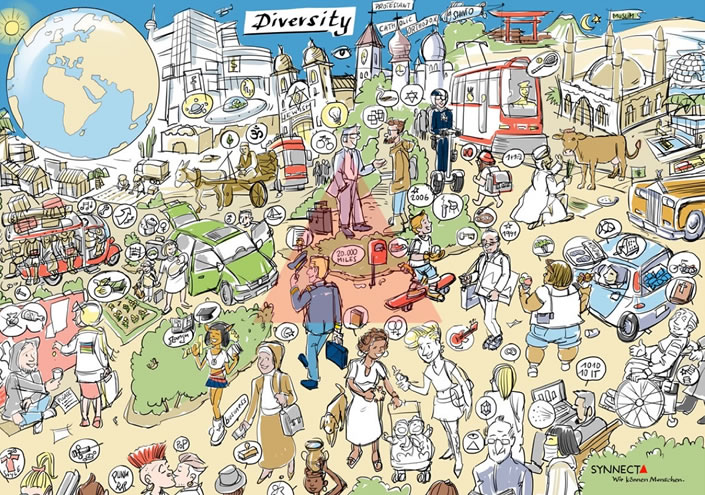
Use the variety of perspectives in your company to become more creative
How do we become more innovative?
This question is becoming increasingly urgent for many companies to keep up with the competition. Without innovation, time is running out for many companies.
The countdown is ticking:
- Is your company already in the starting blocks to »launch« the next innovation?
- Where does the innovative power in your company come from?
The potential for innovation have many companies. It is important to exploit this potential and thus strengthen the company from the inside out. This can mean giving space to lateral thinkers and also taking uncomfortable paths at times. With a disruptive, innovative force, even a monoculture can open up – and thus gain new, innovative perspectives.
Monocultures have a comparatively low complexity – and produce reliable, but also rather boring and predictable answers. Diversity, on the other hand, increases complexity; it counteracts simplifying response patterns – thus providing »blurred« answers with higher ambiguity. This is more demanding – but it also opens up the prospect of better, more groundbreaking solutions.
Learning to ride the tiger – jumping towards more innovation
A plausible thesis is:
»A company can only serve the market that it can internally map.«
This is how Dr. Rüdiger Müngersdorff from the management consultancy SYNNECTA, our cooperation partner in organizational development, puts it.
 Illustration: SYNNECTA Diversity Insight Map®
Illustration: SYNNECTA Diversity Insight Map®
SYNNECTA’s Diversity Insight Map® is a tool with which people are encouraged to engage in dialogue. The topics around diversity become visible and can be discussed.
A healthy diversity in the company does not only ensure that the products and services fit the market. It also promotes a forward momentum within the company that triggers new dialogues and generates ideas. The aim is to constantly rethink and reflect on one’s own certainties and thus be able to act tomorrow.
»Tensions in the company should be good?!« you might ask yourself now. – It is useful to differentiate two types of tension:
- A negative tension describes, for example, a climate of fear, of isolation or personal intrigue. Here, people feel insecure, shut themselves off and tend to only »work to rule«.
- Positive tension, on the other hand, refers to the creative energy generated by allowing different perspectives. Creative processes are not self-propelling, but usually hard work. The joint struggle for the best solution, overcoming mental barriers – the proverbial »out-of-the-box thinking« – all this requires a certain productive tension.
Even agile work or methods such as »design thinking« actively use non-conformist or external perspectives to increase the diversity and thus the creative tension within the system. Those who want to make their company the driving force behind innovations – even disruptive innovations – must not only endure this creative tension, but also actively use it for design purposes. In the free interpretation of a Chinese proverb: You must learn to »ride the tiger«.
Why does diversity become an essential concept for companies?
Promoting diversity in the company is one of the approaches to boosting creative, positive tension. Diversity is a collective term for a multitude of differences. At least the following so-called »diversity dimensions« can be differentiated:
- Cultural differences, often in the sense of ethnic-cultural or religious differences, are regularly understood as relevant differentiation.
- In society, disability is all too often a stigma that leads to a disregard for the potential of people with disabilities – a naive waste of resources from a company’s point of view.
- Gender: The »small« difference between man and woman is clear to everyone. Since 2017, the German Supreme Court (Bundesverfassungsgericht) has distinguished people who do not assign themselves to either of these two categories (official term »diverse«). Reality has always looked more colorful. »Girls play with dolls – boys with cars.« True, if you keep in mind (and preferably say it, too) that many girls also play with cars and many boys with dolls and figures.
- Age: We were all young once – and the hope unites us to become old. But that doesn’t save companies from inter-generational conflicts and misunderstandings in the workforce. Demographic change is fueling this tension: especially when young employees lead older employees – or when the »young« do not feel understood by the »old« – the difference in age suddenly becomes relevant for cooperation within the company.
- Sexual identity or orientation: »It’s a private matter after all« is the cry of naïve conformists. As those belonging to the majority frequently do not understand the concerns of the minority. But it’s not that difficult: Those who feel they have to hide »the private matter« in everyday life in the office or factory hall will be more secretive and focus their energy on secrecy – instead of on the next innovation in the company.
A decisive advantage for entrepreneurs: studies show that diversity in a company benefits them economically. Companies with high diversity are more innovative, have a stronger employer branding and a better working atmosphere. In short: diversity creates dividends.
To innovate you need to understand perspectives and recognize needs
If you want to strengthen the innovative power in your company, you should be able to change your perspective when searching for innovative opportunities. All too often, innovation processes begin with the question: »How can we improve our product?« – Sounds reasonable, but puts the cart before the horse. The initial question should rather be:
- What solution does the customer desire from our offer?
- What problem does our offer solve for the customer?
- From his/her perspective, what becomes easier, faster, better, cheaper …?
This »101 of product development« (but also of sales, marketing, service) is unfortunately often forgotten and many companies first look at their offers from the »technical« side. The result is technical improvements – but they often do not provide any noticeable benefit to the customer. The key question is: »What additional benefits does the innovation create to the customer – from his/her point of view?« Every innovation must pass through the bottleneck of the customer’s perspective – otherwise it is not an innovation but only a variation. In short: Start with the customer’s perspective – not that of your offer!
An example from the DIY (do-it-yourself) sector: Instead of further improving the existing drill from your range, for example by increasing the speed or lowering the price, you might come up with the disruptive idea of developing a strong adhesive strip – after you have understood that most people in the household only need comparatively tiny holes to hang up light objects (towel hooks, pictures, wall mirrors).
But this change of perspective requires at least two skills: On the one hand, you need to be able to cognitively engage with the customer, his context and his challenges. On the other hand – and this is often the difficult part – you have to be able to feel his emotional situation (his »pain«). You need to be able to sense the different needs of the client. So you need a high degree of social empathy.
And this is where diversity and diversity management come in: The more complex my internal cosmos, which I have to manage in my company, the easier it is for me to understand the complex worlds of my customers. Consider: A range of services for women – designed only by men; a machine for the Indian market designed only by German engineers; a range for young people designed only by »old hands«? – Yes, anything is possible, but the chances are high that the target group’s needs will not be met. More promising is the approach of integrating diversity and complexity into one’s own processes at an early stage.
Why diversity promotes agility in your company
Diversity expert Hanna Göhler points out that for agile organizations, the competent handling of diversity is an important prerequisite for being able to use the potential of agile methods. Agility is a cultural issue. She puts forward the thesis:
- »Only those who are aware of diversity in the group, appreciate it and make it usable, can be and work truly agile. This makes diversity a topic of system, culture, leadership and individuality.«
More on this in her readable article »Why agility and diversity belong together«. There she also explains the concept of »diversity learning« as part of a learning culture towards more agility. Hanna Göhler writes:
»Ambiguity tolerance« (i.e. the ability to tolerate ambiguities and differences or even better to accept them) is regarded as a characteristic of diversity awareness. It is also indispensable for the agile mindset. If this ability is lacking, people react to ambiguous and often uncontrollable situations in an agile setting with »linear thinking«. They fall into rigid, old, traditional patterns, the opposite of »being agile« and constructive diversity learning.
How do you set a base from which innovations can grow?
For managers it is important to create a common base and a stable framework in which the creative tension can stimulate ideas and does not become destructive. This also addresses questions of corporate culture, which should be characterized by trust, open feedback and a pronounced sense of community. This is the only way to build bridges and avoid typical silo thinking, e.g. between departments or teams.
Support the diversity and the overarching exchange within the company. Invite open dialogues and disruptive ideas. In workshops and at larger events, focus on the potential that lies in cross-hierarchical, cross-functional or cross-regional exchange. Allow a little more »colorfulness« in the company and make sure that your company is a place where positive tension can unfold its creative power.
For futher reading (in German):
- The article »What are meaningful diversity measures?« answers further questions on the use of a diversity strategy in the company.
- The Bertelsmann Foundation’s Future of Work blog features an article on »Digitization as a Cultural Challenge«.
Daniel Goetz
This article was first published by the author in agateno’s blog at www.agateno.com.
Photo: Matthew Schwartz by unsplash.com
